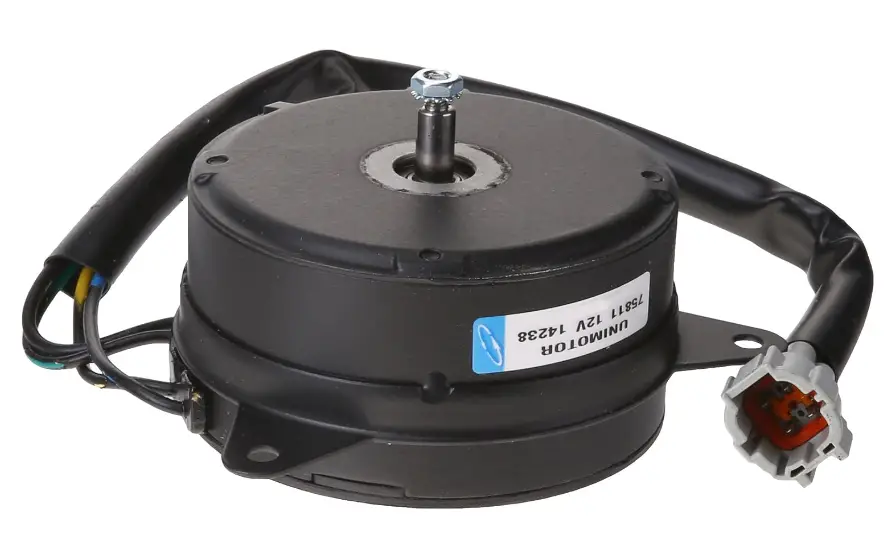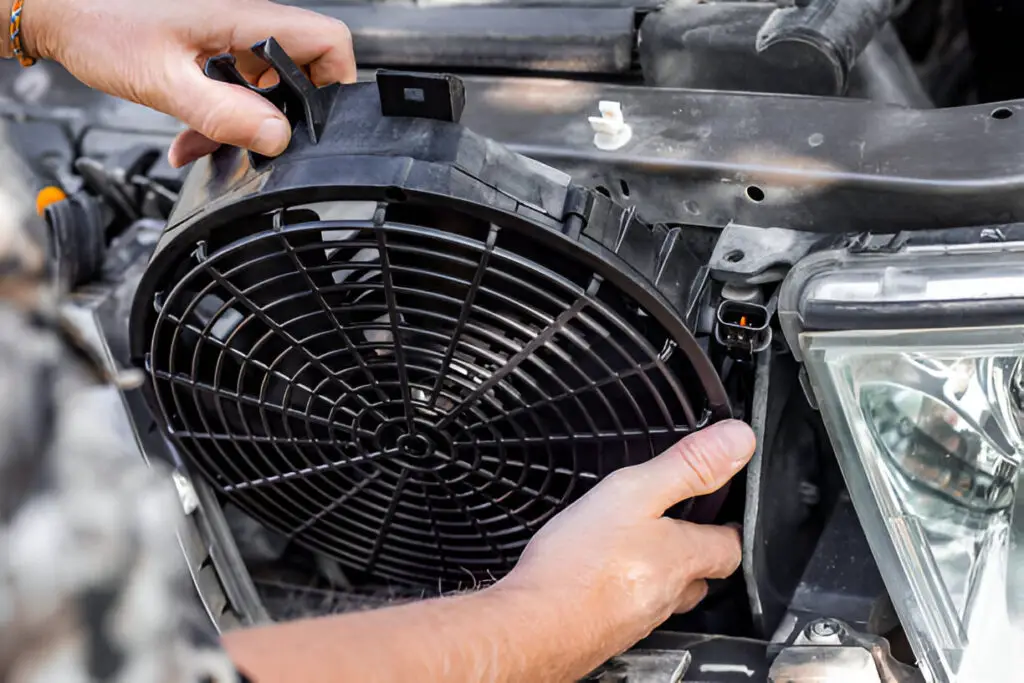Radiator fan motor replacement costs typically range from $300 to $600, including parts and labor. Labor is around $100 to $200, and parts cost $150 to $400, depending on the vehicle. Timely replacement helps prevent engine overheating.
When it comes to maintaining the health of your vehicle, few components are as crucial as the radiator fan. The radiator fan motor plays a vital role in cooling the engine by pulling air through the radiator to regulate engine temperature. If this component fails, it can lead to overheating, which can cause significant engine damage. One of the questions that often comes up during vehicle maintenance is, “What is the cost of replacing a radiator fan motor?”
This article will explore the typical costs involved in replacing a radiator fan motor, the factors that influence the price, symptoms of a failing fan motor, and the importance of timely replacement.

Contents
What Does a Radiator Fan Motor Do?
The radiator fan is responsible for cooling the engine by pulling air through the radiator. It usually activates when the engine is running hot, especially when the car is stationary or moving at low speeds. Without this fan, the engine would quickly overheat, leading to engine failure.
The fan motor powers the radiator fan, so if the motor fails, the fan will no longer function. This can cause overheating, reduced engine performance, and in severe cases, permanent engine damage.
Radiator Fan Motor Replacement Cost
The cost of replacing a radiator fan motor can vary widely depending on several factors such as the type of vehicle, whether you’re using OEM (original equipment manufacturer) parts or aftermarket components, and labor costs.
Average Radiator Fan Motor Replacement Cost
On average, the cost of replacing a radiator fan motor ranges between $300 to $600. This price includes both parts and labor. Labor costs typically range from $100 to $200, depending on the vehicle and where you live, while parts can range from $150 to $400, again depending on the vehicle and whether OEM or aftermarket parts are used.
Factors That Affect Radiator Fan Motor Replacement Costs
Several factors can influence the overall cost of replacing a radiator fan motor, including:
- Make and Model of the Vehicle: Luxury or imported vehicles typically have more expensive parts and require more specialized labor, increasing the overall cost.
- Type of Radiator Fan Motor: Depending on the vehicle, you may have either an electric or mechanical fan motor. Electric fan motors are more common in modern vehicles, while older cars might have a mechanical fan driven by the engine’s belt system.
- OEM vs. Aftermarket Parts: OEM parts are made by the vehicle’s manufacturer and tend to be more expensive, but they offer a better fit and warranty. Aftermarket parts are generally cheaper but may not always match OEM standards in quality or fit.
- Labor Costs: The cost of labor varies based on location and the complexity of the job. In some cases, replacing a radiator fan motor can be straightforward, while in other vehicles, it might require removing several other components, increasing labor time and costs.
- Condition of the Surrounding Components: If other components, such as the radiator itself or electrical wiring, are damaged or worn, the cost of replacement could increase due to additional repairs needed.
DIY Replacement vs. Professional Service
Some vehicle owners may consider replacing the radiator fan motor themselves to save on labor costs. If you’re comfortable working on cars and have the necessary tools, a DIY replacement could save you around $100 to $200. However, if you’re not experienced, it’s better to have the job done by a professional mechanic. Incorrect installation of the fan motor can lead to further damage to the cooling system and engine.

How to Tell Radiator Fan Motor Needs Replacement
Recognizing the symptoms of a failing radiator fan motor early can prevent further damage to your vehicle. Here are some common signs that your radiator fan motor may need replacement:
1. Engine Overheating
The most obvious symptom of a failing radiator fan motor is engine overheating. If the fan isn’t functioning properly, the engine won’t receive adequate cooling, especially when the car is idling or moving slowly.
2. Fan Not Running
If the radiator fan doesn’t activate when the engine is hot, the motor may have failed. You can check this by observing whether the fan spins when the engine reaches a high temperature. If the fan doesn’t turn on, the motor could be the issue. Read article about radiator fan keeps running when car is off.
3. Loud Noise
A failing radiator fan motor may cause a loud grinding or whining noise when it tries to operate. This indicates that the motor is struggling or has worn out.
4. Air Conditioning Issues
The radiator fan motor also plays a role in cooling the air conditioning condenser. If you notice that the AC isn’t as cool as it used to be, or if it only works when the vehicle is moving at higher speeds, the radiator fan motor might be the culprit.
5. Check Engine Light
In some vehicles, a failing radiator fan motor can trigger the check engine light, especially if the engine has overheated multiple times. However, this light can come on for many reasons, so a diagnostic check is necessary to confirm the issue.
The Importance of Timely Replacement
Replacing a faulty radiator fan motor is essential to maintaining your vehicle’s overall health. If the motor fails, the engine can overheat, which can lead to costly repairs such as a blown head gasket, warped cylinder head, or even total engine failure. Regularly monitoring your engine temperature and taking action when you notice signs of a failing radiator fan motor can save you from expensive repairs in the long run.
How Long Does a Radiator Fan Motor Last?
On average, a radiator fan motor can last between 8 to 10 years, or about 80,000 to 100,000 miles, depending on driving conditions, climate, and how well the vehicle is maintained. Extreme temperatures and stop-and-go traffic can shorten the lifespan of the fan motor. Regular inspections during routine maintenance can help identify wear and tear before the motor completely fails.
Frequently Asked Questions
Here are common FAQs about radiator fan motor replacement –
How much does it cost to replace a radiator fan motor?
The average cost to replace a radiator fan motor ranges from $300 to $600, depending on the vehicle type, labor rates, and whether OEM or aftermarket parts are used. Labor typically costs between $100 to $200, while parts range from $150 to $400.
Can I drive my car with a bad radiator fan motor?
It is not advisable to drive with a faulty radiator fan motor, as it can lead to engine overheating, which can cause severe engine damage. If your engine is overheating, you should get the fan motor replaced as soon as possible.
How long does it take to replace a radiator fan motor?
Replacing a radiator fan motor typically takes between 1 to 3 hours, depending on the make and model of the vehicle and the accessibility of the motor. Some vehicles require removing other components to access the fan motor, which can extend the repair time.
Can I replace a radiator fan motor myself?
If you have experience working on vehicles and access to the right tools, you may be able to replace the radiator fan motor yourself. However, for most people, it’s best to leave this repair to a professional mechanic to ensure it’s done correctly.
What causes a radiator fan motor to fail?
Radiator fan motors can fail due to general wear and tear, electrical issues, or exposure to extreme temperatures. Over time, the motor may wear out or suffer damage from debris or moisture, leading to failure.
Conclusion
Radiator fan motor replacement is a critical maintenance task that can prevent engine overheating and extend the life of your vehicle. While the average cost ranges from $300 to $600, it’s important to address any issues with the radiator fan motor as soon as they arise to avoid more expensive repairs down the line. Regularly checking your engine temperature and being aware of the signs of a failing fan motor can help you stay ahead of potential problems. If you’re unsure about replacing the motor yourself, it’s always best to consult with a trusted mechanic to ensure the job is done correctly.